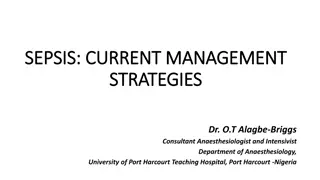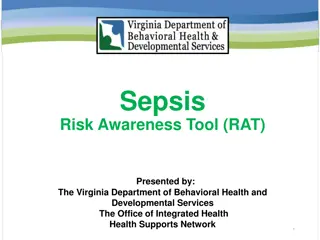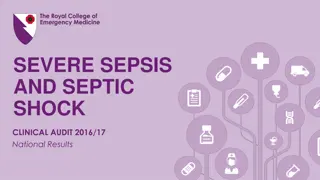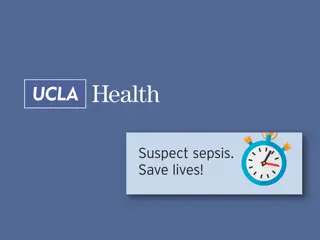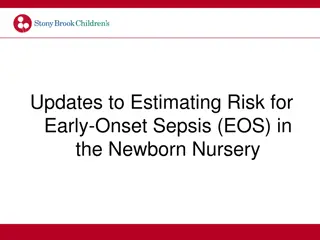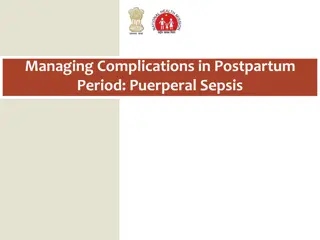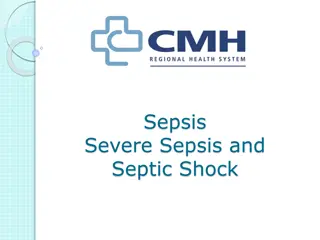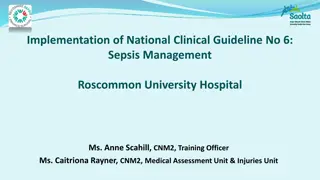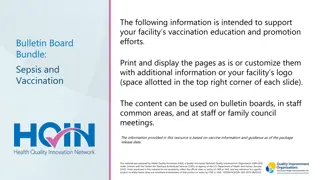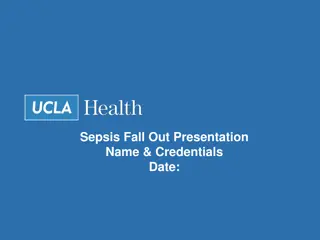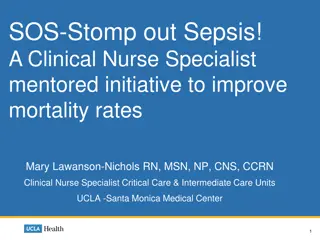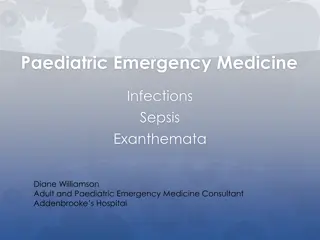Sepsis and its Stages
Sepsis is a severe infection that spreads via the bloodstream, leading to systemic inflammatory response syndrome (SIRS) and potentially life-threatening complications like disseminated intravascular coagulation (DIC) and multiple organ failure. This complex condition requires prompt recognition and appropriate management to prevent adverse outcomes. Learn about the risk factors, pathophysiology, and different stages of sepsis in this informative content.
Download Presentation

Please find below an Image/Link to download the presentation.
The content on the website is provided AS IS for your information and personal use only. It may not be sold, licensed, or shared on other websites without obtaining consent from the author. Download presentation by click this link. If you encounter any issues during the download, it is possible that the publisher has removed the file from their server.
E N D
Presentation Transcript
Sepsis Nurse Practitioner Led Outreach Team (NLOT) 2022 William Osler Health System | Ontario Health Team
Sepsis Severe infection Spreading via the bloodstream Can be bacterial, viral or fungal Can originate from infections in the lungs, kidneys, skin, abdomen etc.
People with decreased immune system such as: Cancer/Chemotherapy/Radiation AIDS Transplant patients Steroid use Infants/Seniors Higher risk in seniors with multiple comorbidities Burn Patients Invasive devices: catheters, intubated Hospitalized patients Who is at risk?
Pathophysiology Inflammation extends beyond the infection site and affects the entire body Disseminated Intravascular Coagulation (DIC): Circulatory system begins to collapse causing microscopic clots in the small vessels in the body Interferes with the body s natural ability to break down clots Leading to organ damage, circulatory system collapse and hemorrhages
Sepsis https://www.biovendor.com/circulating-biomarkers-in-critical-illness-and- sepsis?utm_source=google&utm_medium=organic
Stage of Sepsis 1. Systemic Inflammatory Response Syndrome (SIRS) A clinical response arising from a nonspecific insult Temperature >38 C or <36 C RR >20bpm HR >90bpm WBC >12,000 or <4,000 Monitor
Stage of Sepsis 2. Sepsis 2 SIRS Confirmed or suspected infection Monitor
Stage of Sepsis 3. Severe Sepsis Sepsis One or More Signs of End Organ Damage Hypotension (SBP <90mmHg) Which doesrespond to interventions Monitor
Multiple Organ Failure Brain Liver Kidney Heart Blood Lungs Acutely altered LOC GCS <15 Acute Respiratory Distress Syndrome Elevated LFTs Elevated Bilirubin Elevated Cr Low urine output (Despite fluids) Hypotension >40mmHg drop from baseline B/P Decreased platelets Increased INR (without anticoagulation)
Stage of Sepsis 4. Septic Shock - High Mortality Rate Severe sepsis with persistent: Signs of End Organ Damaged Hypotension (SBP <80mmHg) Which is not responsive to interventions (fluids) Vasopressor therapy needed to maintain MAP >65mmHg Lactate >4mmol/L
Recognition If sepsis is suspected or confirmed it is crucial to monitor closely for signs & symptoms of rapid progression Frontline staff (nurse/PSW) are often 1st to recognized sepsis and/or risk of sepsis Early recognition and rapid response are essential to successful treatment of sepsis
Symptoms Fever or very low body temperature Fever is sometimes absent in the elderly Chills/Rigors Abnormal vital signs ( HR, RR, B/P) Decreased urine output Confusion Rash
Diagnosing Determine the cause: Location Causative agent Cultures: Blood, Urine, Sputum, Wound, CSF Diagnostic Tests: X-Rays, CT Scan, Ultrasound Laboratory Tests: CBC, Lytes, Cr, INR, LFTs
Treatment Antibiotics Supportive Care: Intravenous fluids Ventilator Dialysis Drugs for circulatory failure Parenteral nutrition
Why is this important Early recognition and rapid response are essential to the successful treatment of sepsis Prognosis depends on: age, health status, speed of diagnosis and type of organism Improving outcomes depends on every provider involved in care (including nursing/PSW)
References Guyton, A., & Hall, J. (2000). Textbook of Medical Physiology (p. 260). W.B. Saunders Company (10th Ed.). Mayo Clinic Staff (July 24, 2009). Sepsis., from http://www.mayoclinic.com/health/sepsis/DS01004 Nelson, D., LeMaster, T., Plost, G., & Sahner, M. (2009). Recognizing Sepsis in the Adult Patient. American Journal of Nursing, 109 (3)., from http://journals.lww.com/ajnonline/Fulltext/2009/03000/Recognizing_Sepsis _in_the_Adult_Patient.34.aspx





